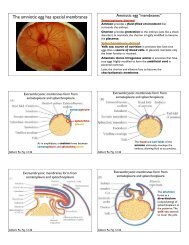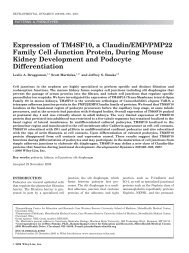WOC 6e Guide to Microscopy
WOC 6e Guide to Microscopy
WOC 6e Guide to Microscopy
You also want an ePaper? Increase the reach of your titles
YUMPU automatically turns print PDFs into web optimized ePapers that Google loves.
Point<br />
of light<br />
Lens<br />
Image plane<br />
View of<br />
image plane<br />
(a) Formation of an image of a single point of light by a lens<br />
3 points<br />
of light<br />
Lens<br />
Image plane<br />
View of<br />
image plane<br />
(b) Formation of an image of a point of light in the presence<br />
of two other points<br />
dx<br />
Tube<br />
of light<br />
Lens Image plane<br />
(c) Formation of an image of a section of an equally bright<br />
tube of light<br />
dx<br />
Lens Image plane<br />
(d) Formation of an image of a brightened section of a<br />
tube of light<br />
View of<br />
image plane<br />
View of<br />
image plane<br />
collect in the image plane arises mainly from that plane of<br />
focus.<br />
Figure A-17 illustrates how these principles are put <strong>to</strong><br />
work in a laser scanning confocal microscope, which illuminates<br />
specimens using a laser beam focused by an objective<br />
lens down <strong>to</strong> a diffraction-limited spot. The position of the<br />
A-12 Appendix Principles and Techniques of <strong>Microscopy</strong><br />
Figure A-16 Paths of Light Through a Single Lens. (a) The image of<br />
a single point of light formed by a lens. (b) The paths of light from<br />
three points of light at different distances from the lens. In the<br />
image plane, the in-focus image of the central point is superimposed<br />
with the out-of-focus rays of the other points. A pinhole<br />
or aperture around the central point can be used <strong>to</strong> discriminate<br />
against out-of-focus rays and maximize the contributions from the<br />
central point. (c) The paths of light originating from a continuum<br />
of points, represented as a tube of light. This is similar <strong>to</strong> a uniformly<br />
illuminated sample. In the image plane, the contributions<br />
from an arbitrarily small in-focus section, dx, are completely<br />
obscured by the other out-of-focus rays; here a pinhole does not<br />
help. (d) By illuminating only a single section of the tube strongly<br />
and the rest weakly, we can recover information in the image plane<br />
about the section dx. Now a pinhole placed around the spot will<br />
reject out-of-focus rays. Because the rays in the middle are almost<br />
all from dx, we have a means of discriminating against the dimmer,<br />
out-of-focus points.<br />
spot is controlled by scanning mirrors, which allow the beam<br />
<strong>to</strong> be swept over the specimen in a precise pattern. As the<br />
beam is scanned over the specimen, an image of the specimen<br />
is formed in the following way. First, the fluorescent<br />
light emitted by the specimen is collected by the objective<br />
lens and returned along the same path as the original incoming<br />
light. The path of the fluorescent light is then separated<br />
from the laser light using a dichroic mirror, which reflects one<br />
color but transmits another. Because the fluorescent light has<br />
a longer wavelength than the excitation beam, the fluorescence<br />
color is shifted <strong>to</strong>ward the red. The fluorescent light<br />
passes through a pinhole placed at an image plane in front of<br />
a pho<strong>to</strong>multiplier tube, which acts as a detec<strong>to</strong>r. The signal<br />
from the pho<strong>to</strong>multiplier tube is then digitized and displayed<br />
by a computer. To see the enhanced resolution that results<br />
from confocal microscopy, look back <strong>to</strong> Figure A-15, which<br />
shows images of the same cell visualized by conventional<br />
fluorescence microscopy and by laser scanning confocal<br />
microscopy.<br />
As an alternative <strong>to</strong> laser scanning confocal microscopy,<br />
a spinning disc confocal microscope uses rapidly spinning discs<br />
containing a series of small lenses and a corresponding series<br />
of pinholes. Although it cannot produce optical sections<br />
as thin as laser scanning microscopes can produce, it can<br />
generate confocal images that can be acquired rapidly using<br />
sensitive digital cameras. Such speed is useful for visualizing<br />
very rapid events within cells.<br />
In confocal microscopy, a pinhole is used <strong>to</strong> exclude ou<strong>to</strong>f-focus<br />
light. The result is a sharp image, but molecules<br />
above and below the focal plane of the objective lens are still<br />
being excited by the incoming light. This can result in rapid<br />
bleaching of the fluorescent molecules; in some cases, especially<br />
when viewing living cells that contain fluorescent molecules,<br />
such bleaching releases <strong>to</strong>xic radicals that can cause<br />
the cells <strong>to</strong> die. To reduce such “pho<strong>to</strong>damage,” it would<br />
be desirable if only the fluorescent molecules very close <strong>to</strong><br />
the focal plane being examined were excited. This is possible<br />
using multipho<strong>to</strong>n excitation microscopy. In multipho<strong>to</strong>n<br />
excitation microscopy, a laser that emits pulses of light very<br />
rapidly and with very high energy is used <strong>to</strong> irradiate the
















